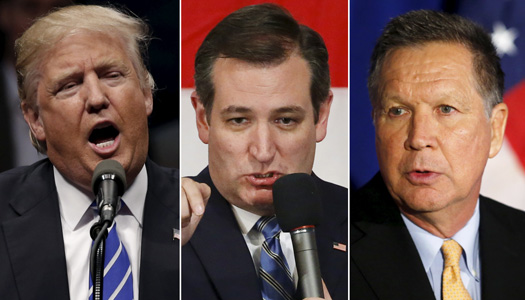
When John Boehner stepped down as Speaker of the House last fall, everyone assumed his deputy, Kevin McCarthy, would quickly take up the position. Facing intense opposition from the Tea Party-backed Freedom Caucus, however, McCarthy beat a hasty retreat and the party had to persuade a reluctant Paul Ryan to step up. Republicans tried to put a positive spin on things: Ryan was the “unity candidate.” No one really bought it though. What we actually witnessed was a sneak preview of the party’s 2016 presidential race.
The reactionary populist base that GOP leaders have been all too happy to wield against Obama and the Democrats for years appears to have slipped out of their control. With the Trump-Cruz-Kasich race still going strong, some in the commentariat have even begun entertaining notions that the GOP is entering a state of collapse. The fact that all the so-called establishment candidates like Bush, or to a lesser extent Rubio and Walker, are long gone, leaving Trump and Cruz at the head of the pack, certainly wasn’t how things were supposed to go. But claims that the party is entering its death throes are more than a little exaggerated, even if it is clear that the party faces serious division at the national level.
That is only part of the story, though. If we only pay attention to the presidential contest, we could miss out on some important factors in this election.
At the down-ticket level, the GOP machine still retains a considerable degree of unity and capacity. Heavy infusions of cash at the Congressional and state levels continue to fuel the Right (both inside and outside the party proper). Looking beyond the race for the White House, what we find is a policy and funding network that is still quite effective at guaranteeing Republican dominance.
These seemingly contradictory trends are part of a major political realignment underway which could reshape politics in the United States. As is often the case, ours is a time of both danger and opportunity.
Breakdown of the New Right coalition
It would appear that what we are witnessing right now is the breakdown of the New Right coalition that has kept the Republican Party (mostly) unified for the past 35 years. That’s not to say there haven’t been dissidents or personality clashes along the way, but since Reagan’s victory in 1980, there has been a generally united stance within the GOP that has allowed it to successfully advance its ultra-right agenda.
McCarthyism was the first inkling of this force, but it really started to coalesce with the Goldwater campaign of 1964. It became more coherent when Nixon married segments of big business and educated urban/suburban Republicans to rural constituencies with his racist “Southern Strategy,” and then emerged in its full form with Reagan’s election.
It is this hegemonic grouping which finished off the Democratic Party’s New Deal Coalition and replaced it as the dominant ideological and political trend in our country. It combined major sections of capital, neoliberal free market advocates, libertarians, and Evangelical fundamentalists.
This mix has come under strain, however, due to a number of factors: the prolonged economic crisis and slow recovery; the increased differentiation of capital between advanced globally-oriented sectors like finance, high-tech, and energy on the one hand and domestically-oriented small and medium capital in sectors like services, small manufacturing, and regional energy exploration on the other; and the profound demographic shifts reshaping the population of the United States. Immigrants, people of color, and other formerly minority communities are making up ever-larger proportions of our country. And the younger generation is leaning to the political left.
Relatedly, it is also clear that these emerging divisions are linked to changes in the voting base of the Republican Party (and also that of the Democrats). White, non-union, non-college educated voters now make up around half of the GOP voting base (even though they are only 36 percent of the national voter total); while only a quarter of the Democratic electorate come from this group. The Republican Party is becoming more reliant on this segment of voters at precisely a time when their overall share in the population is decreasing. The group is also replacing the GOP’s shrinking segment of educated upper-income professionals earning over $100,000 a year, who now split almost 50/50 between the two parties.
As this group of voters – those who have lost out in globalization and free trade – grows into a larger share of the Republican electorate, we are seeing their clout reflected in the surging support for candidates like Trump. He articulates, however crudely, the insecurities that the last few decades have created for them. Cruz draws on such sentiments to a certain extent as well, but his approach to public policy draws more on his Evangelical outlook. There is, of course, much overlap in all of these categories.
A time of differentiation is unfolding for the American Right. What we are witnessing is a reconfiguration of the Republican electorate. It is not, however, the end of the Republican Party – contrary to what some on the left are celebrating and others in GOP circles are lamenting.
Factions, capital, and the nomination
With Trump and Cruz marching ahead, the party establishment, such as it is, is probably wringing its hands and doesn’t know what to do at this point. It is possible that some have accepted that it is better to lose to Clinton than to support Trump, but beyond that there’s little agreement on what to do next.
Do they go all out to stop him from getting the nomination and risk splitting the party – jeopardizing their chances not just this election but also in the future? Or do they let him have his place at the head of the ticket and then sit on their hands and hope he flops? Or do they actually put effort and resources behind an alternative conservative candidacy?
These are not easy questions to answer, and GOP leaders are probably not getting clear direction from their partners in business either. Aside from the voting base outlined earlier, Trump also appeals to significant parts of the small business sector that is needed by the party for both money and votes. But it seems highly unlikely that much of the larger corporate sectors are at all excited about Trump, or Cruz for that matter. Some would probably prefer to get behind Kasich, but he has little electoral legitimacy and not much hope at this time.
Considerable segments of the finance and high-tech sectors will likely go for Clinton, just as they did for Obama. Their business is so international that many are unwilling to risk putting someone in the White House who even verbally threatens to close open borders and restrict free trade. For them, the main criterion is competent management of the capitalist system. If Republicans could combine their low-tax/no-regulation agenda with toned-down social issue stances and competent leadership, most of these folks would probably be eager to accommodate themselves to a GOP nominee. But as it stands, it doesn’t look like the party will be able to fit the bill.
Oil, agriculture, and the resource sectors would almost certainly prefer an establishment candidate in the mold of Jeb Bush, however, there is really no one viable at this point. But with fracking bans, carbon taxes, and green energy filling the speeches of Clinton and Sanders, they will probably back any Republican when it comes down to the wire.
Enduring strength down-ticket
It is clear by now that the factional divisions at the top of the GOP are real enough, but as mentioned, this is only part of the equation.
In states and localities across the country, a policy and funding infrastructure is in place which still provides a surprising level of organizational unity and institutional capacity for the ultra-right. This has particular significance for state-level contests and the struggle to control Congress.
Since 2008, the Republicans are up 69 seats in the House, 13 in the Senate, 900-plus in state legislatures, and 12 governorships. Though at the national level it might look like the GOP is in big trouble, the last eight years have been extremely successful for the party. They control what laws get considered by Congress and they decide electoral boundaries and voting laws in thirty states. The stranglehold they enjoy over state governments, combined with gridlock in Congress, enables the right to push through their agenda on a state-by-state basis. Their hold on these levers of power will not be broken just by a Democrat winning the presidency.
A coordinated network of some 60+ state-level right-wing think-tanks and policy institutes – like ALEC, the Texas Public Policy Foundation, and others – continues to vigorously promote an anti-labor and anti-public services agenda in almost every electoral district in the nation.
They provide ready-made policy recommendations and research to Republican state legislators, governors, and members of Congress – still far outpacing anything that the center-left has been able to put together. Many of them also spin themselves as pragmatic centrist groups, so their policy products even show up in the legislative proposals of some Democrats. A similar network of “family policy” institutes, which are really Evangelical outfits, do the same dirty work when it comes to social policy issues like abortion and LGBT equality.
It is here – at these down-ticket levels – that the extreme concentration of wealth and the undermining of democracy is perhaps being felt most strongly. This is where Citizens United is wreaking some of its worst damage. The Koch Brothers, for instance, focus the bulk of their political spending and activities at these levels – not on the national presidential campaigns.
Their network of billionaire funders plans to spend $869 million dollars on the 2016 election – an amount on par with what the two major parties each plan to spend this year.
These realities point to the need for labor and the left to continue giving just as much focus to city, county, state, and Congressional races as they do to the presidential campaigns.
Possibilities for realignment?
Taken together, these developments all point to a political realignment in the United States. Demographically, the current Republican voting coalition is not on a path to long-term sustainability or growth. The shift toward a more moderate center-right party that many elements of the GOP establishment hoped to pull off for the 2016 election will have to take place eventually. After enough times losing at the presidential level, the forces inside the party advocating for change will gain traction.
Years from now, this period might be looked back on by Republicans in the same way Democrats view 1968-92. It was a time of Congressional dominance for the party, but with the one-off exception of Jimmy Carter, it was shut out of the White House. The 2016 GOP nominee – especially if it is Trump or Cruz – could one day be seen as the Republicans’ version of George McGovern, assuming that the Democratic nominee wins.
If this is the case, the years ahead will be transitional ones for the GOP nationally as it seeks to formulate new ways to market itself. This could mean that opportunities for advancing a left-labor democratic agenda are possible, as we have seen with the rapid growth of the Fight for $15 and other movements in the recent period.
Lest anyone begin anticipating smooth sailing from here on out, though, it is necessary to keep in mind that the ultra-right’s hold on Congress and many states is likely to continue for the foreseeable future. As the GOP message loses its appeal among an increasing number of Americans, the party will rely even more on redistricting and voting rights restrictions to shore up its electability, a response Bernie Sanders has described as political cowardice.
But in general, what we see right now is a reopening of the ideological divide in American politics. For Republicans, the pressure to move to the center will increase – especially if the party loses the presidential election.
To the left of center, the factional gap appears in the form of a strong liberal-left grouping around Sanders, which is setting the pace for the party’s traditionally centrist wing, attached to Clinton. The latter group finds itself forced to adapt to a new period when the old third way ideology is losing currency.
All sides are fluid. But in the long-term, there are reasons to be cautiously optimistic. It won’t be easy, and there will still be reversals and hurdles along the way. Labor and the people’s movements still haven’t harnessed their potential transformative power. But if a broad majoritarian coalition can be consolidated to capitalize on these openings, there could be a period of more advances ahead.
The Republicans will undoubtedly regroup at some point and again start to match at a national level what they are already doing on the state and local levels. The democratic movements can’t afford to miss the current window of opportunity.
Photo: AP












Comments